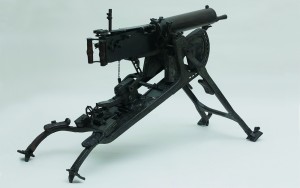Maxim machine-gun
Published in Artefacts, Issue 4 (July/August 2014), Volume 22
A 1908 German Maxim machine-gun. (Irish Defence Forces)
The first true modern machine-gun was created by American inventor Hiram Maxim in 1884. Indeed, the four greatest names of machine-gun history—Gatling, Maxim, Browning and Lewis—were all Americans. There had been machine-guns created in time for the American Civil War (1861–5) but these were hand-cranked. In 1915 Maxim recalled being told in 1882: ‘Hang your chemistry and electricity! If you want to make a pile of money, invent something that will enable these Europeans to cut each others’ throats with greater facility.’ This he did by designing a machine-gun that, once you kept your finger on the trigger, fired continuously, using the power from the fired bullet to reload and fire again. In 1892 Vickers in England and in 1893 Krupps in Germany took out Maxim patents, followed by Russia and the United States. By 1917 all the armies except Austria were using the same weapon, although manufactured locally. Sales of the Maxim machine-gun were limited prior to the First World War; it was largely ignored by generals and was confined to colonial wars in Africa. Vickers only provided eleven machine-guns per year to the British Army before the war, but by 1918 they were supplying over 40,000 per annum. From 1914 to 1918 they made over a quarter of a million Vickers, Lewis and Hotchkiss machine-guns. Before the war there was a belief in personal heroism and that the main aim of war was to attack, not to defend. Officers were very conservative in their opinions and often contemptuous of technology; their training focused on lessons learnt from military history rather than on planning for future wars. For 30 years the experiences of various colonial wars were ignored but were learned very quickly by all armies in the autumn of 1914, and at great cost.
This particular machine-gun is a 1908 German Maxim on loan to the National Museum of Ireland from the Irish Defence Forces. In the years leading up to the Great War, especially after the Russian–Japanese war of 1904, the German Army started to take the machine-gun more seriously and by 1914 had more machine-guns than any other army. For the Battle of the Somme in July 1916, when c. 7,000 Irishmen were to become casualties, the Germans had perfected the procedure of leaving their deep dugouts with their machine-guns and assembling them in three minutes, ready to fire. A machine-gun like this one with a crew of five German soldiers firing 500 rounds a minute could defend a trench from a battalion of 750 attacking soldiers, who could never get close enough to destroy them. It would take four years of trial and error to create modern tactics of fire and manoeuvre and weapons such as the tank to defeat the threat posed by a well-defended machine-gun.
Lar Joye is curator of military history at the National Museum of Ireland (Decorative Arts).
















